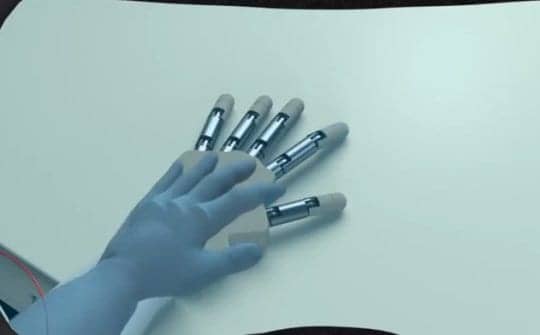
According to researchers, amputees can learn to feel that their phantom limb actually grows into their prosthetic hand. (Photo courtesy of Ecole Polytechnique Fédérale de Lausanne)
Using an approach that combines virtual reality and artificial tactile sensations, a team of scientists has enabled two amputees to feel as though their prosthetic hand belongs to their own body.
The scientists, in a collaboration led by Ecole polytechnique fédérale de Lausanne, also suggest that the phantom limb actually grows into the prosthetic hand.
Their study was published recently in the Journal of Neurology.
The idiom “seeing is believing” is not enough to help amputees with the use of their prosthetic limb. Many amputees opt out of prolonged use of their prosthetic limb because their missing limb simply does not fit their prosthesis. In other words, their own perception of the missing limb, or the brain’s representation of it, does not match up with what they see of the prosthesis.
The underlying problem is twofold. Amputees still feel their missing limb, even if it is physically gone, and this ghost limb—aka phantom limb—is perceived as much smaller that the lost limb. Next, the commercially available prosthetic limb does not yet provide sensory feedback other than what the patient sees, meaning that the patient has no sense of touch from the prosthetic limb and must constantly watch it for correct use, explains a media release from Ecole Polytechnique Fédérale de Lausanne.
“The brain regularly uses its senses to evaluate what belongs to the body and what is external to the body. We showed exactly how vision and touch can be combined to trick the amputee’s brain into feeling what it sees, inducing embodiment of the prosthetic hand with an additional effect that the phantom limb grows into the prosthetic one,” explains Giulio Rognini of EPFL’s Laboratory of Cognitive Neuroprosthetics led by Olaf Blanke, in a collaboration with Silvestro Micera of EPFL and Scuola Superiore Sant’Anna in Italy
In two hand amputees, the scientists provided artificial tactile sensations at the tip of the index finger—of the phantom limb—by stimulating the patient’s nerve in the stump. At the same time, the patient wore virtual reality goggles that showed the index finger of the prosthetic limb glowing in synchrony with the administered touch sensations.
Both patients reported feeling as though the prosthetic hand belonged to their own body. Moreover, when asked to evaluate the position of their hands, both patients felt as though their phantom limb had extended into the prosthetic limb.
Previous to the experiment, they both reported that the phantom hand was small and directly connected to the stump, as if the phantom limb had no forearm. In fact, their phantom limb extended during the experiment, and remained extended for up to 10 minutes afterwards.
The experiment simply requires the patient to passively observe two sensations on the fingertip, the visual glow and the artificial touch happening in synchrony, in order for embodiment and extension of the phantom limb to take place, the release continues.
“The setup is portable and could one day be turned into a therapy to help patients embody their prosthetic limb permanently,” Rognini adds.
[Source(s): Ecole Polytechnique Fédérale de Lausanne, Science Daily]



